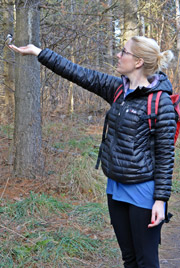Our bird populations need your help
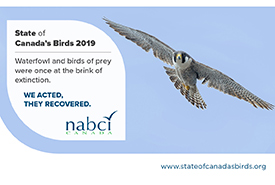
Peregrine falcon (Photo by Jacques Bouvier)
As summer emerges, Canadians are enjoying nicer weather and the sights and sounds that nature brings us.
But bird songs, once a familiar sound, are become increasingly faint whether at the local park or in our own backyard.
The 2019 State of Canada’s Birds Report has been issued by Environment and Climate Change Canada, on behalf of the North American Bird Conservation Initiative (NABCI). It is the first report in seven years.
In Canada, NABCI is made up of many organizations and agencies that are supporting efforts to conserve birds and their habitats. They include federal, provincial and territorial governments and land conservation groups such as Ducks Unlimited Canada and the Nature Conservancy of Canada (NCC). Other members are Nature Canada, Bird Studies Canada, Wildlife Habitat Canada along with the Canadian Cattlemen’s Association, Canadian Electricity Association, Canadian Mining Association and the Forest Products Association of Canada.
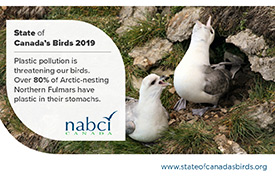
Northern fullmars (Photo by Matt Mallory)
The 2019 State of Canada’s Birds Report, released June 20, looks at the population trends of over 400 birds since 1970. While some birds are doing better thanks to conservation efforts, the report issues a stark warning: the diversity and abundance of Canada’s birds are declining.
The report, which can be found at stateofcanadasbirds.org, also gives tips on how we can all help conserve birds by reducing plastic pollution, keeping cats inside and making backyards bird-friendly. The data was gathered by biologists, and by citizen scientists who play a valuable role in bird counts and monitoring.
Listen to a radio interview with NCC's Kristyn Ferguson about the report >
Here are some of the key findings of the report:
- Bird species dependent on native grasslands have decreased by 87 per cent.
- Our grasslands have lost an estimated 300 million birds since 1970.
- Migratory shorebirds have decreased by 40 per cent.
- Long-distance migratory shorebirds have declined by 55 per cent.
- Aerial insectivore birds have decreased by 59 per cent.
- 55 of 58 seabirds that use Canadian waters are ranked as special concern, and 20 species are at risk of extinction.
Shorebird, grassland and aerial insectivore bird populations make up 80 per cent of all bird species that were assessed as threatened or endangered in Canada over the last decade.
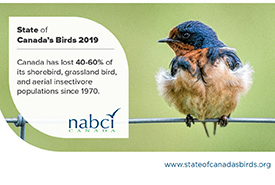
Barn swallow (Photo by Glen Springer)
The report cites reasons why populations have declined. They include habitat loss, unsustainable agricultural practices, climate change and pollution. These issues impact birds on their Canadian breeding grounds, during their migration and on their wintering areas.
On the positive side, the report found that habitat conservation and a ban on DDT have helped waterfowl and birds of prey, respectively, to recover. Since 1970, populations of birds of prey have increased by 110 per cent while duck numbers have increased by 150 per cent from historic population lows in the 1970s. The waterfowl management community in the United States and Canada developed a strategy, the North American Waterfowl Management Plan (NAWMP), to restore duck populations through habitat protection and restoration.
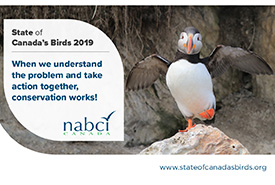
Atlantic puffin (Photo by Christian Marcotte)
NCC is working to protect habitat for many birds across Canada. In Ontario, in Carden Alvar and Napanee Plain, we have focused our efforts on acquiring land for grassland birds, including the eastern loggerhead shrike. Also known as the butcher bird, this predatory songbird is more endangered than the panda. With less than 30 breeding pairs remaining in the wild, the eastern loggerhead shrike is one of the fastest-declining bird species in North America.
The federal government recently announced the Natural Heritage Conservation Program, with a goal of protecting 200,000 hectares (more than 494,000 acres) of our lands and waters over the next four years. NCC and other members of the land trust community rely on this matching fund. We bring together private citizens, businesses and family and community foundations to help conserve important habitats for birds.
This year marks the 30th anniversary of the North American Wetlands Conservation Act. The resulting funding support from this agreement via the U.S. Fish and Wildlife Service, Canadian governments and conservation groups has been a major driver in the recovery of waterfowl. Where investments have been made, continentally, in wetlands conservation for waterfowl, there has been recovery. This gives us hope that we can reverse the declines in other bird groups through habitat protection, community involvement and coordinated conservation efforts across the range of these birds.

